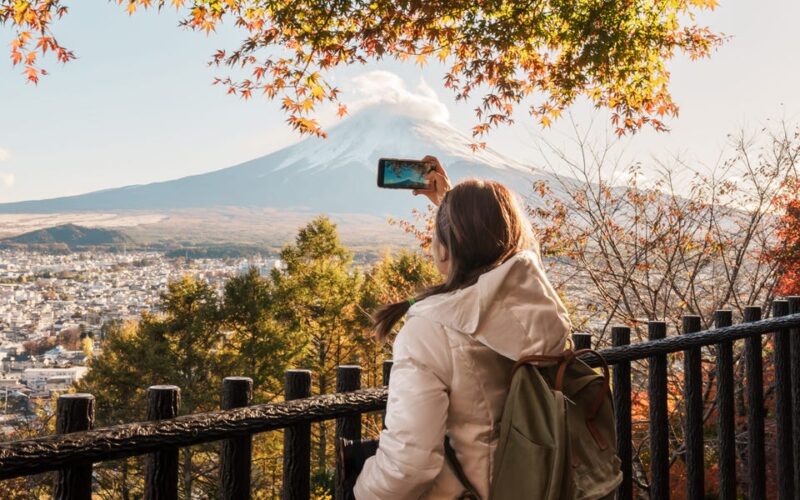- Japan Airlines has offered free domestic flights to international tourists visiting Japan.
- The initiative aims to promote travel to lesser-known destinations.
- But travel experts warn it may worsen overtourism in popular cities like Tokyo and Kyoto.
Japan Airlines is giving free domestic flights to international tourists, making travel to smaller cities and hidden gems far easier.
But travel experts say the initiative is likely to backfire, as it could exacerbate the country’s overtourism problem.
The initiative was announced in September and is available to people traveling to Japan from the US, Canada, Mexico, Thailand, Australia, New Zealand, Vietnam, the Philippines, Indonesia, India, China, and Taiwan.
In order to obtain the free tickets, passengers must book round-trip international flights with Japan Airlines and domestic flights within the same purchase.
A spokesperson for Japan Airlines said no end date has been set for the initiative.
It could intensify over-tourism
Sara Aiko, founder of the travel agency Curated Kyoto, told BI that the initiative was likely created to distribute tourism to lesser-known areas to alleviate overtourism in the capital.
But in practice, Aiko said, “people will continue to flock to popular destinations like Tokyo, regardless of free tickets, because they are major attractions.”
© Marco Bottigelli/Getty Images
Earlier this year, the Japanese government estimated that it would surpass its target of getting 32 million international tourists by 2025 after 8.6 million people visited in the first quarter of 2024.
Ben Julius is the founder of Tourist Japan, a travel agency that offers tour packages across Japan to travelers from around the globe.
Speaking to BI, Julius said around 90% of his clients visit the same popular locations: Tokyo, Kyoto, Mount Fuji, and Osaka.
“The majority of visitors are first-time visitors,” he said. “And when people visit Japan for the first time, they won’t miss the must-see cities.”
However, overtourism in these areas is majorly disrupting the lives of locals, who have to deal with rising hotel prices and misbehaving tourists.
“Hotel prices have skyrocketed due to tourism, making it difficult for many locals to stay at places they used to enjoy,” Aiko said.
Meanwhile, in April, authorities in Yamanashi erected an eight-foot-tall barrier to prevent tourists from taking photos at a convenience store with views of Mount Fuji.
PHILIP FONG/Getty Images
The move came after complaints about the behavior of international tourists, including littering and bad parking.
BBC News reported in August that the barrier had been removed in preparation for a typhoon, but authorities said it would be re-erected if tourists returned in large numbers.
Duncan Greenfield-Turk, CEO of the travel agency Global Travel Moments, told BI that Japan has been a top-booked destination for his clients for the past three years.
He said he has noticed the “immersive pressure” on the country’s public transport system, hotels, and attractions, “particularly in smaller towns not equipped for mass tourism.”
International visitor spending is expected to reach 6.3 trillion Japanese yen, or around $42 billion, by the end of 2024, according to research by the World Travel and Tourism Council.
Employment within the travel and tourism industry is also expected to climb. The organization estimates more than 6 million new jobs will be created this year, which they said is a 10% increase from 2023.
One reason tourists are spending more money is the weak yen. Since the start of 2022, the yen has lost more than 20% against the dollar, and it reached a 38-year low of 161.96 to the dollar in July.
Greenfield-Turk said Japan Airlines’ initiative has the potential to stretch the economic benefits of mass tourism to less-visited areas.
However, without proper direction, he said it “could simply encourage more travel to already strained regions, intensifying the overtourism problem.”
“If tourists continue to gravitate toward popular destinations rather than exploring new ones, the initiative could backfire,” he said.
There’s also the possibility that tourists will opt out of the new initiative.
Amy Thomasson, a Japan travel advisor for Travelmation, told BI that it “doesn’t make sense for most travelers” because of the additional costs that could be accumulated.
The airline said travelers from the US, Canada, Mexico, and China who plan to stay in their first destination for more than 24 hours will be charged a $100 layover fee.
Instead, Thomasson suggests that tourists utilize Japan’s high-speed trains.
Business Insider’s Monica Humphries previously wrote about her experience traveling between Tokyo and Kyoto on the Hikari Shinkansen, a high-speed bullet train, and noted that it was clean, comfortable, and quick.
Source link
lol

